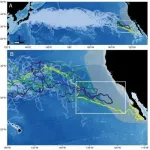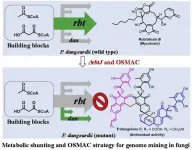(Press-News.org) "Not all those who wander are lost ... "
--J.R.R. Tolkien
Known as "the lost years," it is a little-understood journey that unfolds over thousands of miles and as much as two decades or more. Now, a Stanford-led study illuminates secrets of the North Pacific loggerhead turtles' epic migration between their birthplace on the beaches of Japan and reemergence years later in foraging grounds off the coast of Baja California. The study, published April 8 in Frontiers in Marine Science, provides evidence for intermittent passages of warm water that allow sea turtles to cross otherwise inhospitably cold ocean barriers. The findings could help inform the design of conservation measures to protect sea turtles and other migratory sea creatures amid climatic changes that are altering their movements.
"For decades, our ability to connect the migratory dots for this endangered species has remained elusive," said study lead author Dana Briscoe, who was a research associate at the Stanford Woods Institute for the Environment during the research and now works at the Cawthron Institute, New Zealand's largest independent marine science organization. "This work builds on the backbone of exceptional research about these 'lost years,' and for the first time ever we are excited to provide evidence of a 'thermal corridor' to explain a longstanding mystery of one of the ocean's greatest migrants."
Endangered migrants
Wildlife seekers thrill to the sight of sea turtles, but ship traffic, fishing nets and other perils have been less kind. The International Union for Conservation of Nature lists six of the seven sea turtle species as critically endangered, endangered or vulnerable.
Despite scientific advancements in core habitat use, we still know precious little about the movement of turtles and other long-lived sea creatures between disparate locations. This knowledge gap makes it impossible to effectively assess and protect these species.
The researchers wanted to know how and why some loggerheads travel to the western coastline of North America while others remain in the central Pacific Ocean. How is it that some sea turtles - creatures highly sensitive to temperature - can cross a frigid zone called the Eastern Pacific Barrier between the two ocean regions that normally stops most creatures in their tracks?
To unlock that mystery, the researchers created the largest dataset on satellite-tagged loggerhead sea turtles ever compiled, employed sophisticated remote sensing oceanographic techniques and collected one of the first detailed records of sea turtle aging and stable isotope testing - a bone analysis that can be used to provide information about an animal's life. The work relied upon decades of research by the international team of scientists.
They started by looking at a 15-year study tracking the movements of more than 200 turtles tagged with satellite tracking devices. Six of the turtles caught the researchers' attention because - unlike their peers - they made distinct movements toward the North American coast. Adding to the intrigue, the "sentinels," as the researchers called them, made their journey during the early spring months. A look at remotely sensed ocean conditions for the time period showed that the farthest-roaming of the sentinels swam through water significantly warmer than their peers had confronted on their travels.
A bigger picture analysis involved identifying the years loggerheads arrived in Baja California by measuring stable isotope "fingerprints" in the bones of sea turtles stranded on beaches there. Because like us, turtles are what they eat, these stable isotope signatures can reveal when the turtles transitioned from the open sea to the coast. The analysis showed significantly greater annual numbers of eastward-bound sea turtles during warm ocean conditions.
The likely cause, according to the researchers: the development of a "thermal corridor" from unusually warm sea surface temperatures due to El Niño and other intermittent warming conditions that allowed the turtles to cross the Eastern Pacific Barrier to coastal foraging grounds.
The corridor was present during the late spring and summer, and was also preceded by early warming of temperatures in the months before it opened. Such anomalous conditions, especially if sustained for several months, may provide key environmental cues to sea turtles and other animals concentrated in the eastern edge of the central Pacific that the thermal corridor is opening. Studies combining data from loggerhead aerial surveys, at-sea-sightings, stranding records and tissue samples supported the hypothesis.
A dangerous trend
The phenomenon may be part of a trend. As the planet undergoes unprecedented climate changes, locations once considered impassable obstacles to species movements, like the Eastern Pacific Barrier, are being redefined. This, in turn, is shifting the distributions and migratory pathways of creatures ranging from sea birds to white sharks and presenting new conservation challenges.
For the North Pacific loggerhead, the trend could mean higher exposure to bycatch - unintentional fisheries harvest - off the Baja California coast and other potentially important North American foraging grounds, including the Southern California Bight. The study provides important insights, such as an understanding of how animal movements relate to climate variation, that could help predict when sea turtles and other protected species could be vulnerable to such threats.
The researchers caution that their multi-year dataset represents only a snapshot of an important developmental period for sea turtles. The small number of turtles that moved into the eastern North Pacific limits the ability to fully test the study's hypothesis under varying conditions. To do that, the researchers call for more satellite tagging and stable isotope studies of turtle bones in this region.
"Understanding how and why species like the North Pacific loggerhead move among habitats is crucial to helping them navigate threats," said study senior author Larry Crowder, the Edward Ricketts Provostial Professor at Stanford's Hopkins Marine Station. "Emerging technologies and analyses can help illuminate these journeys."
INFORMATION:
Crowder is also a professor of biology in the School of Humanities and Sciences and a senior fellow at the Stanford Woods Institute for the Environment. Co-authors of the study include Calandra Turner Tomaszewicz and Jeffrey A. Seminoff of the NOAA National Marine Fisheries Service; Denise Parker and George Balazs of Golden Honu Services of Oceania; Jeffrey Polovina of the University of Hawai'i at Mānoa; Masanori Kurita and Hitoshi Okamoto of the Port of Nagoya Public Aquarium (Japan); Tomomi Saito of K?chi University (Japan); and Marc Rice of Hawai'i Preparatory Academy.
Funding for this study provided by the Crowder Lab at Stanford's Hopkins Marine Station, the National Marine Fisheries Service, the National Academy of Sciences, Stanford's Department of Biology and the Stanford Woods Institute for the Environment.
The Perseverance rover has just landed on Mars. Meanwhile, its precursor Curiosity continues to explore the base of Mount Sharp (officially Aeolis Mons), a mountain several kilometres high at the centre of the Gale crater. Using the telescope on the ChemCam instrument to make detailed observations of the steep terrain of Mount Sharp at a distance, a French-US team headed by William Rapin, CNRS researcher at the Institut de Recherche en Astrophysique et Planétologie (CNRS/Université Toulouse III/CNES) (1), has discovered that the Martian climate recorded there alternated between dry and wetter periods, before drying up completely about 3 billion years ago. Spacecraft in orbit ...
Heart failure and stroke are unusual diagnoses among younger people. But they are now clearly on the rise in men below the age of 40, according to a University of Gothenburg study. The scientists have found links to obesity and low fitness in the upper teens.
The present study, published in Journal of Internal Medicine, includes data on 1,258,432 men who, at an average age of 18.3 years, enlisted for military service in Sweden between 1971 and 1995.
Particulars of the men's weight, height and physical fitness on enlistment were merged with data in the National Board of Health and Welfare's National Patient Register and Cause of Death Register for the period 1991-2016. From when they enlisted, the men were thus monitored over a period exceeding 20 years.
The proportion ...
Researchers at GMI - Gregor Mendel Institute of Molecular Plant Biology of the Austrian Academy of Sciences - uncover an ingenious mechanism by which Arabidopsis safeguards the integrity of its genome. The paper is published in the journal Nature Cell Biology.
Is it possible for one single gene product to silence undesirable genetic elements? Can such a strong effect be seen in the regulation of Transposable Elements (TEs), or genome parasites? If yes, how does this gene product singlehandedly keep transposons in check? New research from Frédéric Berger's group at GMI provides answers to these questions and dissects a mechanism of gene silencing that has long remained shrouded in mystery.
Genome parasites
Although jumping transposons promote ...
Flamingo chicks raised by foster parents from another flamingo species develop normally, scientists say.
Six Chilean flamingo chicks were reared by Andean flamingos - a species of similar size and behaviour - at WWT Slimbridge Wetland Centre in the summer of 2018.
University of Exeter scientists studied the chicks' behaviour after they re-joined the Chilean flamingo flock early in 2019.
The results showed fostering had no negative effects, with fostered flamingos still forming stable social ties - making "friends" and behaving like parent-reared birds.
"Slimbridge's Andean flamingos hadn't nested for about 20 years," said Dr Paul Rose, of the University of Exeter.
"But in the ...
Novel PF74-like small molecules targeting the HIV-1 capsid protein: Balance of potency and metabolic stability
https://doi.org/10.1016/j.apsb.2020.07.016
Of all known small molecules targeting human immunodeficiency virus (HIV) capsid protein (CA), PF74 represents by far the best characterized chemotype, due to its ability to confer antiviral phenotypes in both early and late phases of viral replication. However, the prohibitively low metabolic stability renders PF74 a poor antiviral lead. The authors report on their medicinal chemistry efforts ...
A consortium of researchers from Russia, Belarus, Japan, Germany and France led by a Skoltech scientist have uncovered the way in which Mycobacterium tuberculosis survives in iron-deficient conditions by utilizing rubredoxin B, a protein from a rubredoxin family that play an important role in adaptation to changing environmental conditions. The new study is part of an effort to study the role of M. tuberculosis enzymes in developing resistance to the human immune system and medication. The paper was published in the journal Bioorganic Chemistry.
According to the World Health Organization, every year 10 million people fall ill with tuberculosis and about 1.5 million die from it, making it the world's top infectious killer. ...
A great need for better pain treatment
After an appendectomy, a quarter (24.8%) of all children wanted a stronger pain treatment in the first 24 hours after their operation. Among children who had a tonsillectomy, this was one-fifth (20.2%). Analysis of the data showed that this desire was primarily associated with sleep impairments and with movement pain. The lead author of the study, Prof. Ulrike M. Stamer, explained: "We are dealing with a large number of affected patients. Appendectomies and tonsillectomies are the most common operations performed on children overall. Just under a quarter of these cases strongly signal a desire for
improvement".
A comprehensive, multicentre study
This study is based on the international pain registry "PAIN OUT infant", which was established ...
TAMPA, Fla. (April 8, 2021) -- A dysfunctional immune system significantly contributes to the development of cancer. Several therapeutic strategies to activate the immune system to target cancer cells have been approved to treat different types of cancer, including melanoma. However, some patients do not show beneficial clinical responses to these novel and very promising immunotherapies. In a new article published in Proceedings of the National Academy of Sciences of the United States of America, Moffitt Cancer Center researchers demonstrate how an important defect in STING gene expression in melanoma cells contributes to their evasion from immune cell detection and destruction.
Several different mechanisms have been discovered ...
Genome mining combined metabolic shunting and OSMAC strategy of an endophytic fungus leads to the production of diverse natural products
Endophytic fungi are promising producers of bioactive small molecules. Bioinformatic analysis of the genome of an endophytic fungus Penicillium dangeardii revealed 43 biosynthetic gene clusters, exhibited its strong ability to produce numbers of secondary metabolites. However, this strain mainly produce rubratoxins alone with high yield in varied culture conditions, suggested most gene clusters are silent. Efforts for mining the cryptic gene clusters in P. dangeardii, including epigenetic regulation and one-strain-many-compounds (OSMAC) approach were failed probably due to the high yield of rubratoxins. A metabolic ...
A team of archaeologists in north-west the Kingdom of Saudi Arabia has uncovered the earliest evidence of dog domestication by the region's ancient inhabitants.
The discovery came from one of the projects in the large-scale archaeological surveys and excavations of the region commissioned by the Royal Commission for AlUla (RCU).
The researchers found the dog's bones in a burial site that is one of the earliest monumental tombs identified in the Arabian Peninsula, roughly contemporary with such tombs already dated further north in the Levant.
Evidence ...






